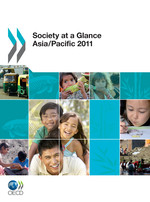Chinese Taipei
Society at a Glance - Asia/Pacific Edition 2011
See latest Edition Society at a Glance - Asia/Pacific 2014
Please cite as: OECD(2011), Society at a Glance - Asia/Pacific Edition
Bookmark this page: www.oecd.org/els/social/indicators/asia
Press material - Downloads: free publication & data files
|
|
|
|
Chapter 1. How do People in the Asia/Pacific Region Spend Their Time? (.PDF). |
This TRAFFIC LIGHT summary table allows you to compare where your country stands across selected indicators (.xls) |
|
General Context Indicators GE1. GDP per capita GE2. Fertility GE3. Marriage and divorce GE4. Migration GE5. Support rate |
Self-sufficiency Indicators SS1. Employment SS2. Unemployment SS3. Education SS4. Early childhood education SS5. Education spending |
|
|
Equity Indicators EQ1. Poverty EQ2. Inequality EQ3. Gender Ratio EQ4. Pensions EQ5. Social spending |
Health Indicators HE1. Life expectancy HE2. Infant mortality HE3. Water and sanitation HE4. Adult height HE5. Health expenditure |
|
Social Cohesion Indicators CO1. Life satisfaction CO2. Trust CO3. Social behaviours CO4. Suicide CO5. Voting |
||
Related data/publications:
- ADB: Social Protection Index for Committed Poverty Reduction
- ILO: Key Indicators of the Labour Market online (KILM) database
- IMF: World Economic Outlook online database
- UN: World Population Prospects online database
- UNESCAP: Statistical Yearbook for Asia and the Pacific
- World Bank: World Development Indicators online database
Further information
For further information, questions or feedback, please contact:
Luca Lorenzoni or Maxime Ladaique from the OECD's Employment, Labour and Social Affairs Directorate,
Related Documents
